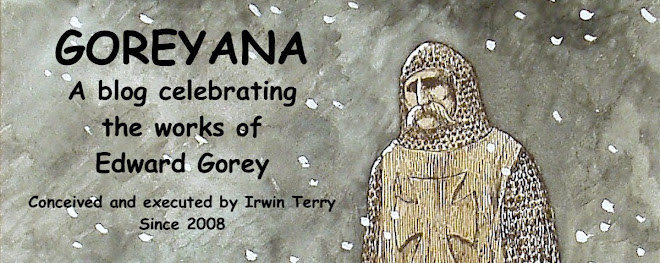 After the 1973 whirlwind of publishing several of his own books, completing multiple illustration projects for other authors and tackling the theater designs for Dracula in Nantucket, Edward Gorey did not publish any new books again until 1975 (Categor y was published in 1974, but only because of printing delays - Mr. Gorey's involvement with the project was completed in time for the original publication date in 1973). This might lead one to believe that Mr. Gorey was taking some time off or went traveling after such a busy time, but that is something he never did!
After the 1973 whirlwind of publishing several of his own books, completing multiple illustration projects for other authors and tackling the theater designs for Dracula in Nantucket, Edward Gorey did not publish any new books again until 1975 (Categor y was published in 1974, but only because of printing delays - Mr. Gorey's involvement with the project was completed in time for the original publication date in 1973). This might lead one to believe that Mr. Gorey was taking some time off or went traveling after such a busy time, but that is something he never did!For the first time since his show at the Mandrake Bookstore in the early 1950's (see my posting from October 10, 2008), Edward Gorey was preparing new pieces for a gallery exhibition which was being organized by The Graham Gallery in Manhattan. Mr. Gorey created 46 original pieces of art for the exhibition, entitled Plain & Coloured Drawings by Edward Gorey. In an interview from 1977, Mr. Gorey stated that since his early days as an artist up to the time of the Graham show he rarely, if ever, created art without a purpose (commission work, or for one of his own books), so this exhibition was a unique experience for him, and a rare treat for his admirers.
 A four page gallery booklet was created showing five of the pieces that were in the exhibition. The booklet included a short essay by Brendan Gill about Mr. Gorey's work. I have a two page mimeographed checklist from the gallery which lists the titles of the pieces included in the show - I am not sure if this checklist was something that was created for gallery use only or was given to prospective buyers. My copy of the booklet is signed and inscribed by Mr. Gorey. The art in the exhibition was available for purchase. At this stage in his career Mr. Gorey rarely sold original art, so having an opportunity to view and purchase pieces was a special opportunity. The show was successful enough that Graham featured Mr. Gorey again in 1975.
A four page gallery booklet was created showing five of the pieces that were in the exhibition. The booklet included a short essay by Brendan Gill about Mr. Gorey's work. I have a two page mimeographed checklist from the gallery which lists the titles of the pieces included in the show - I am not sure if this checklist was something that was created for gallery use only or was given to prospective buyers. My copy of the booklet is signed and inscribed by Mr. Gorey. The art in the exhibition was available for purchase. At this stage in his career Mr. Gorey rarely sold original art, so having an opportunity to view and purchase pieces was a special opportunity. The show was successful enough that Graham featured Mr. Gorey again in 1975. The titles of the pieces (from the checklist) shown at the gallery were:
The titles of the pieces (from the checklist) shown at the gallery were:1. Trying to feed the baby to the dog
2. Two children on a rock (in my collection)
3. Cell
4. Chinese life
5. Dancing on the Sabbath (pictured in booklet, shown above)
6. Animals and wall
7. China design: picnic
8. Birds and car
9. Animals and train (pictured in booklet, shown below)
 10. Ballet dancer on skull
10. Ballet dancer on skull11. Football player with skull (pictured in booklet, shown above)
12. Bathroom wallpaper design
13. Animals and urn
14. After a Staffordshire sugarbowl
15. Child on swing
16. The white butterfly
17. A dull afternoon
18. Platter design
19. Man and floating skull
20. Unpleasant fan design
21. Blue urns (in my collection)
22. Plain & Coloured Drawings (cover of booklet, shown at top of post)
23. Verso: Plain & Coloured Drawings (rear cover of booklet, shown below)
 24. Discrete self-portrait
24. Discrete self-portrait25. Tennis
26. Animal going to a party
27. Animal holding banner
28. String dance I - IIII
29. Cat on cardboard rocks
30. Cat with umbrella and flower
31. Cat wearing long scarf
32. Cat inside empty picture frame
33. Cat drawing wallpaper
34. Cat between andirons
35. Cat on mantelpiece
36. Cat in portable niche
37. Cat at the devil's thimble
38. Masked cat behind pillar
39. Masked cat dancing beside pool
40. Cat at the corner of a carpet
41. Cat composing a poem
42. Cat appearing between parting clouds
43. Cat ascending on a piece of stage machinery
44. Ninety nine puppies wearing orange knitted caps
45. Waxworks
46. Peas
Apart from the five pieces reproduced in the booklet and two pieces in my collection, I have not seen any art from this show. I assume that the pieces were sold and are in collections as opposed to being lodged in the estate archives since I have never heard of any of the images from this show being exhibited or reproduced since their debut in 1974. I would love to see more of the pieces from the list above. I will be showing the two pieces of art I own in later postings.
































